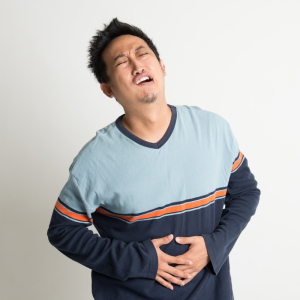Introduction
Cryptosporidium parvum is one of the smallest parasites that lives in the water and resists chlorination. For most people it does not cause a problem as they only experience a minor stomach flu or no symptoms at all. In patients with a weak immune system Cryptosporidium becomes a major health threat.
Such patients (for instance aids patients) come down with cryptosporidiosis, a chronic form of cryptosporidium infestation. Several large U.S. and Canadian cities had sporadic waterborne outbreaks. After an incubation time of 7 days patients develop an explosive watery diarrhea. They have abdominal pains, feel sick, may have a low grade fever and a loss of appetite. After about 1 or 2 weeks of this symptoms disappear. As the patients are usually not vomiting, they do not get dehydrated, but some may have so much diarrhea that they need to be hospitalized for intravenous rehydration. In AIDS patients an infection specialist knowledgeable in this disease needs to be consulted. The same is true for microsporidiosis (infection with Microsporidia), which is another small parasite that affects up to about 30% of AIDS patients and causes chronic diarrhea.
Diagnosis
Apart from the history, which is slightly different for the different underlying causes, stool cultures need to be ordered, in some patients blood cultures and when meningitis symptoms are present, a lumbar puncture may be required. The samples are cultured in special media to identify positively the offending agent. Special blood tests may have to be sent for heavy metal poisoning. From a public Health point of view, the doctor may need to alarm the health authorities to initiate epidemiological studies with analysis of food, water and the environment. In the meantime the physician will concentrate on treating his/her patient.
Treatment
In the treatment of gastroenteritis there are always general measures for any case, which means that fluids, electrolytes and blood have to be replaced. Serial blood tests are used to determine that the body chemistry returns to normal.
For a minor viral gastroenteritis the treatment consists of avoidance of protein as this is most difficult to digest for a few days. So the intake concentrates mainly on carbohydrates (bread, noodles, rice), fat (butter or margarine) and fluids such as pop and chicken broth. When the diarrhea subsides, protein can gradually be reintroduced, first chicken, then pork and finally beef and milk products. If the tests came back identifying a cause, a decision needs to be made whether it is necessary to treat the offending agent. For instance, if it was a toxin that caused the illness, there is usually no reason to treat by the time the patient is recovering from the effect. Similarly the enteric viruses are usually self-limiting. However, when bacterial cultures show a positive result and the patient is still sick, the doctor likely will treat with appropriate antibiotics.
References
1. M Frevel Aliment Pharmacol Ther 2000 Sep (9): 1151-1157.
2. M Candelli et al. Panminerva Med 2000 Mar 42(1): 55-59.
3. LA Thomas et al. Gastroenterology 2000 Sep 119(3): 806-815.
4. R Tritapepe et al. Panminerva Med 1999 Sep 41(3): 243-246.
5. The Merck Manual, 7th edition, by M. H. Beers et al., Whitehouse Station, N.J., 1999. Chapters 20,23, 26.
6. EJ Simchuk et al. Am J Surg 2000 May 179(5):352-355.
7. G Uomo et al. Ann Ital Chir 2000 Jan/Feb 71(1): 17-21.
8. PG Lankisch et al. Int J Pancreatol 1999 Dec 26(3): 131-136.
9. HB Cook et al. J Gastroenterol Hepatol 2000 Sep 15(9): 1032-1036.
10. W Dickey et al. Am J Gastroenterol 2000 March 95(3): 712-714.
11. M Hummel et al. Diabetologia 2000 Aug 43(8): 1005-1011.
12. DG Bowen et al. Dig Dis Sci 2000 Sep 45(9):1810-1813.
13. The Merck Manual, 7th edition, by M. H. Beers et al., Whitehouse Station, N.J., 1999.Chapter 31, page 311.
14. O Punyabati et al. Indian J Gastroenterol 2000 Jul/Sep 19(3):122-125.
Further references
15. S Blomhoff et al. Dig Dis Sci 2000 Jun 45(6): 1160-1165.
16. M Camilleri et al. J Am Geriatr Soc 2000 Sep 48(9):1142-1150.
17. MJ Smith et al. J R Coll Physicians Lond 2000 Sep/Oct 34(5): 448-451.
18. YA Saito et al. Am J Gastroenterol 2000 Oct 95(10): 2816-2824.
19. M Camilleri Am J Med 1999 Nov 107(5A): 27S-32S.
20. CM Prather et al. Gastroenterology 2000 Mar 118(3): 463-468.
21. MJ Farthing : Baillieres Best Pract Res Clin Gastroenterol 1999 Oct 13(3): 461-471.
22. D Heresbach et al. Eur Cytokine Netw 1999 Mar 10(1): 7-15.
23. BE Sands et al. Gastroenterology 1999 Jul 117(1):58-64.
24. B Greenwood-Van Meerveld et al.Lab invest 2000 Aug 80(8):1269-1280.
25. GR Hill et al. Blood 2000 May 1;95(9): 2754-2759.
26. RB Stein et al. Drug Saf 2000 Nov 23(5):429-448.
27. JM Wagner et al. JAMA 1996 Nov 20;276 (19): 1589-1594.
28. James Chin, M.D. Control of Communicable Diseases Manual. 17th ed., American Public Health Association, 2000.
29. The Merck Manual, 7th edition, by M. H. Beers et al., Whitehouse Station, N.J., 1999. Chapter 157, page1181.
30. Textbook of Primary Care Medicine, 3rd ed., Copyright © 2001 Mosby, Inc., pages 976-983: “Chapter 107 – Acute Abdomen and Common Surgical Abdominal Problems”.
31. Marx: Rosen’s Emergency Medicine: Concepts and Clinical Practice, 5th ed., Copyright © 2002 Mosby, Inc. , p. 185:”Abdominal pain”.
32. Feldman: Sleisenger & Fordtran’s Gastrointestinal and Liver Disease, 7th ed., Copyright © 2002 Elsevier, p. 71: “Chapter 4 – Abdominal Pain, Including the Acute Abdomen”.
33. Ferri: Ferri’s Clinical Advisor: Instant Diagnosis and Treatment, 2004 ed., Copyright © 2004 Mosby, Inc.







